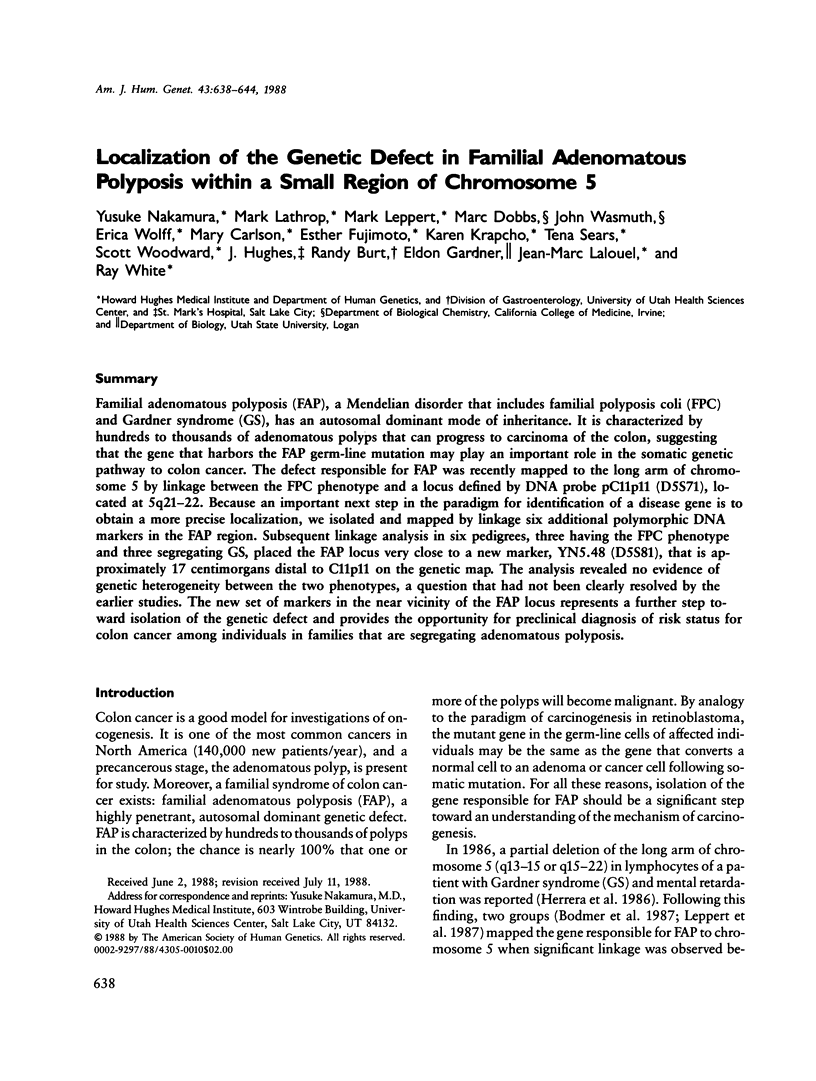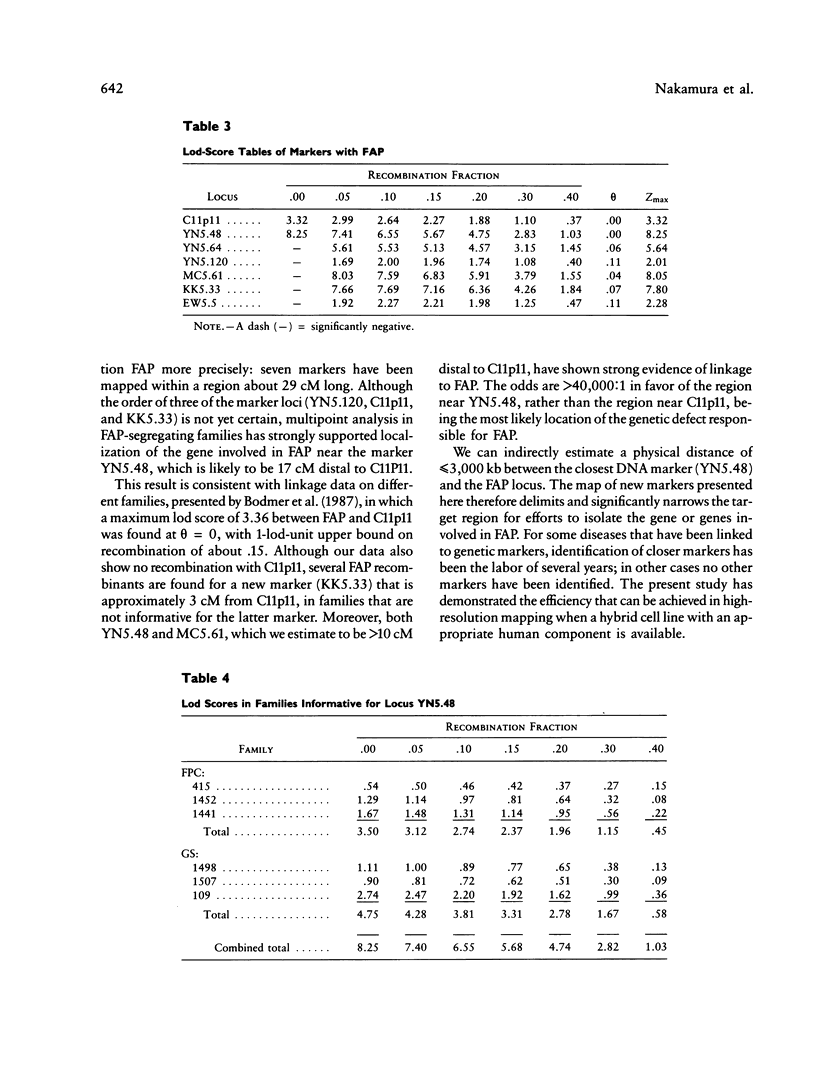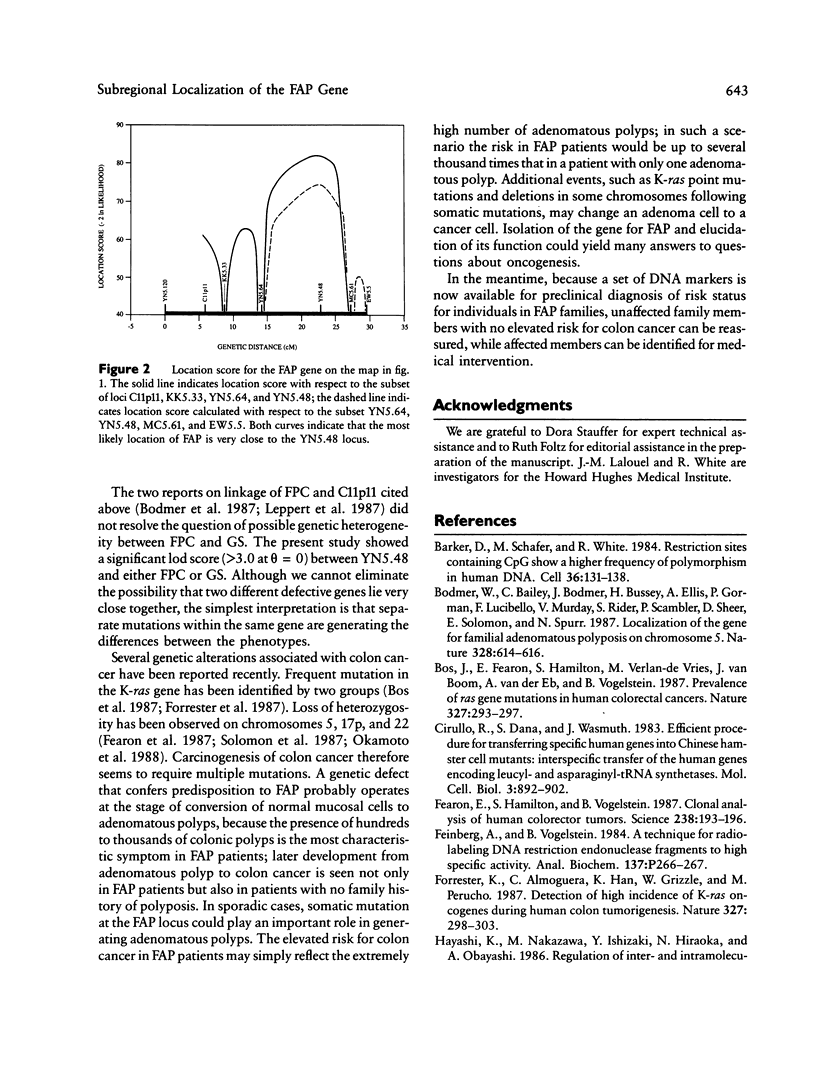Abstract
Familial adenomatous polyposis (FAP), a Mendelian disorder that includes familial polyposis coli (FPC) and Gardner syndrome (GS), has an autosomal dominant mode of inheritance. It is characterized by hundreds to thousands of adenomatous polyps that can progress to carcinoma of the colon, suggesting that the gene that harbors the FAP germ-line mutation may play an important role in the somatic genetic pathway to colon cancer. The defect responsible for FAP was recently mapped to the long arm of chromosome 5 by linkage between the FPC phenotype and a locus defined by DNA probe pC11p11 (D5S71), located at 5q21–22. Because an important next step in the paradigm for identification of a disease gene is to obtain a more precise localization, we isolated and mapped by linkage six additional polymorphic DNA markers in the FAP region. Subsequent linkage analysis in six pedigrees, three having the FPC phenotype and three segregating GS, placed the FAP locus very close to a new marker, YN5.48 (D5S81), that is approximately 17 centimorgans distal to C11p11 on the genetic map. The analysis revealed no evidence of genetic heterogeneity between the two phenotypes, a question that had not been clearly resolved by the earlier studies. The new set of markers in the near vicinity of the FAP locus represents a further step toward isolation of the genetic defect and provides the opportunity for preclinical diagnosis of risk status for colon cancer among individuals in families that are segregating adenomatous polyposis.
Full text
PDF






Selected References
These references are in PubMed. This may not be the complete list of references from this article.
- Barker D., Schafer M., White R. Restriction sites containing CpG show a higher frequency of polymorphism in human DNA. Cell. 1984 Jan;36(1):131–138. doi: 10.1016/0092-8674(84)90081-3. [DOI] [PubMed] [Google Scholar]
- Bodmer W. F., Bailey C. J., Bodmer J., Bussey H. J., Ellis A., Gorman P., Lucibello F. C., Murday V. A., Rider S. H., Scambler P. Localization of the gene for familial adenomatous polyposis on chromosome 5. Nature. 1987 Aug 13;328(6131):614–616. doi: 10.1038/328614a0. [DOI] [PubMed] [Google Scholar]
- Bos J. L., Fearon E. R., Hamilton S. R., Verlaan-de Vries M., van Boom J. H., van der Eb A. J., Vogelstein B. Prevalence of ras gene mutations in human colorectal cancers. 1987 May 28-Jun 3Nature. 327(6120):293–297. doi: 10.1038/327293a0. [DOI] [PubMed] [Google Scholar]
- Cirullo R. E., Dana S., Wasmuth J. J. Efficient procedure for transferring specific human genes into Chinese hamster cell mutants: interspecific transfer of the human genes encoding leucyl- and asparaginyl-tRNA synthetases. Mol Cell Biol. 1983 May;3(5):892–902. doi: 10.1128/mcb.3.5.892. [DOI] [PMC free article] [PubMed] [Google Scholar]
- Fearon E. R., Hamilton S. R., Vogelstein B. Clonal analysis of human colorectal tumors. Science. 1987 Oct 9;238(4824):193–197. doi: 10.1126/science.2889267. [DOI] [PubMed] [Google Scholar]
- Feinberg A. P., Vogelstein B. "A technique for radiolabeling DNA restriction endonuclease fragments to high specific activity". Addendum. Anal Biochem. 1984 Feb;137(1):266–267. doi: 10.1016/0003-2697(84)90381-6. [DOI] [PubMed] [Google Scholar]
- Forrester K., Almoguera C., Han K., Grizzle W. E., Perucho M. Detection of high incidence of K-ras oncogenes during human colon tumorigenesis. 1987 May 28-Jun 3Nature. 327(6120):298–303. doi: 10.1038/327298a0. [DOI] [PubMed] [Google Scholar]
- Hayashi K., Nakazawa M., Ishizaki Y., Hiraoka N., Obayashi A. Regulation of inter- and intramolecular ligation with T4 DNA ligase in the presence of polyethylene glycol. Nucleic Acids Res. 1986 Oct 10;14(19):7617–7631. doi: 10.1093/nar/14.19.7617. [DOI] [PMC free article] [PubMed] [Google Scholar]
- Herrera L., Kakati S., Gibas L., Pietrzak E., Sandberg A. A. Gardner syndrome in a man with an interstitial deletion of 5q. Am J Med Genet. 1986 Nov;25(3):473–476. doi: 10.1002/ajmg.1320250309. [DOI] [PubMed] [Google Scholar]
- Lathrop G. M., Lalouel J. M., Julier C., Ott J. Multilocus linkage analysis in humans: detection of linkage and estimation of recombination. Am J Hum Genet. 1985 May;37(3):482–498. [PMC free article] [PubMed] [Google Scholar]
- Lathrop M., Nakamura Y., Cartwright P., O'Connell P., Leppert M., Jones C., Tateishi H., Bragg T., Lalouel J. M., White R. A primary genetic map of markers of human chromosome 10. Genomics. 1988 Feb;2(2):157–164. doi: 10.1016/0888-7543(88)90098-5. [DOI] [PubMed] [Google Scholar]
- Leppert M., Dobbs M., Scambler P., O'Connell P., Nakamura Y., Stauffer D., Woodward S., Burt R., Hughes J., Gardner E. The gene for familial polyposis coli maps to the long arm of chromosome 5. Science. 1987 Dec 4;238(4832):1411–1413. doi: 10.1126/science.3479843. [DOI] [PubMed] [Google Scholar]
- Monaco A. P., Neve R. L., Colletti-Feener C., Bertelson C. J., Kurnit D. M., Kunkel L. M. Isolation of candidate cDNAs for portions of the Duchenne muscular dystrophy gene. Nature. 1986 Oct 16;323(6089):646–650. doi: 10.1038/323646a0. [DOI] [PubMed] [Google Scholar]
- Okamoto M., Sasaki M., Sugio K., Sato C., Iwama T., Ikeuchi T., Tonomura A., Sasazuki T., Miyaki M. Loss of constitutional heterozygosity in colon carcinoma from patients with familial polyposis coli. Nature. 1988 Jan 21;331(6153):273–277. doi: 10.1038/331273a0. [DOI] [PubMed] [Google Scholar]
- Royer-Pokora B., Kunkel L. M., Monaco A. P., Goff S. C., Newburger P. E., Baehner R. L., Cole F. S., Curnutte J. T., Orkin S. H. Cloning the gene for an inherited human disorder--chronic granulomatous disease--on the basis of its chromosomal location. Nature. 1986 Jul 3;322(6074):32–38. doi: 10.1038/322032a0. [DOI] [PubMed] [Google Scholar]
- Solomon E., Voss R., Hall V., Bodmer W. F., Jass J. R., Jeffreys A. J., Lucibello F. C., Patel I., Rider S. H. Chromosome 5 allele loss in human colorectal carcinomas. Nature. 1987 Aug 13;328(6131):616–619. doi: 10.1038/328616a0. [DOI] [PubMed] [Google Scholar]


